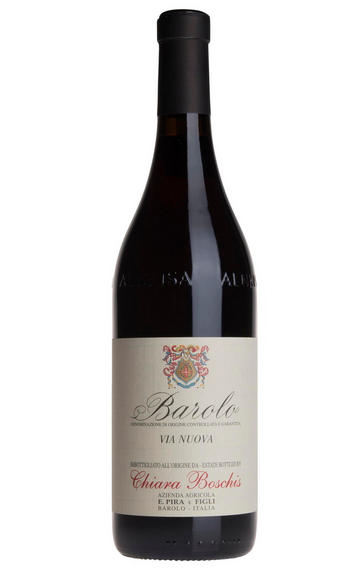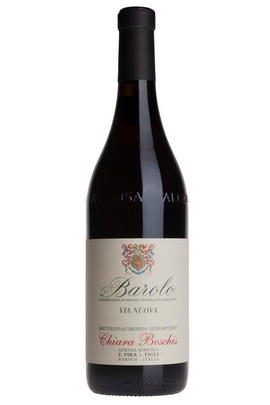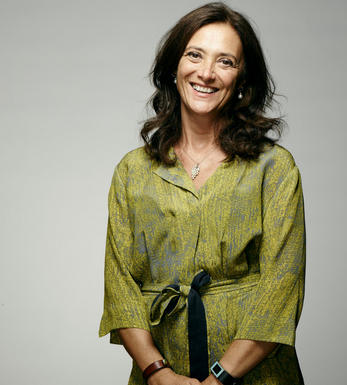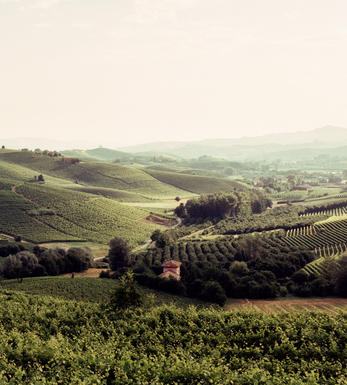
2018 Barolo, Via Nuova, E. Pira di Chiara Boschis, Piedmont, Italy

Critics reviews
The 2018 Barolo Via Nuova is marked by palpable brightness and tension that lend energy. Like all of these wines, the 2018 is restrained in feel, but all the elements are so well balanced. Freshly cut flowers, mint, crushed rocks, chalk and white pepper give the Via Nuova notable energy. Intense veins of supporting tannin and minerality provide the backbone.
Chiara Boschis turned out a set of beautiful and expressive Barolos in 2018 that in some ways remind me of the 2012s. Boschis shortened fermentations a touch, as many growers did, to about nine days for the Cannubi and Mosconi and about 11 days for the Via Nuova vineyards. Malos were all done in steel. As has been the case here in recent years, the Barolos are aged in a combination of cask and smaller neutral French oak, with a preference for cask for the more delicate wines of Barolo and smaller barrels for the firmer wines of Monforte and Serralunga.
Drink 2024 - 2038
Antonio Galloni, Vinous.com (February 2022)
This is an organic blend of fruit from six MGA sites: Terlo and Liste (in Barolo), Ravera di Monforte and Mosconi (in Monforte d’Alba) and Gabutti and Baudana (in Serralunga d’Alba). According to time-tested local tradition, the 2018 Barolo Via Nuova is fermented in steel and aged in oak. This mid-weight blended Barolo has a more prominent herbal or balsam signature at the back of red and purple fruits, liquorice and pressed violet. Production is 13,000 bottles.
Chiara Boschis was the first producer to earn a certification for organics in the town of Barolo. She makes three outstanding expressions of Barolo: Barolo Cannubi (in Barolo); the Barolo Mosconi (from newly acquired vineyards in Monforte d’Alba); and the Barolo Via Nuova, which is a blend of fruit from six sites: Terlo and Liste (in Barolo), Ravera di Monforte and Mosconi (in Monforte d’Alba) and Gabutti and Baudana (in Serralunga d’Alba). She also launched the Cannubi Biologico initiative, which seeks to convert all producers who work in the Cannubi MGA to organics. So far, her grassroots movement has won over 25 of the 28 winegrowers present there.
Drink 2025 - 2045
Monica Larner, Wine Advocate (June 2022)
A fragrant and elegant red, delivering tuberose, strawberry, cherry and grassy aromas and flavors. Taut and balanced, with bright floral and red fruit notes gracing the lingering finish.
Drink 2024 - 2038
Bruce Sanderson, Wine Spectator (September 2022)
Fascinating aromatic complexity that keeps your nose hovering over the glass. Raspberries with ginger biscuits, flowers and a twist of basil. There’s a deeper layer of crushed goji berries and talc-like minerals, too. Full, intense, silky and dainty with well-integrated tannins that even add a chocolatey touch. From organically grown grapes.
So tempting to drink now, but better from 2024.
James Suckling, JamesSuckling.com (October 2022)
The 2018 Barolo Via Nuova is fresh and lifted, with a really fresh approach. Supple with red fruit, red roses, and fresh orange, on the palate it offers fine tannins, a graceful, clean finish with a chalky texture, and a Burgundian aesthetic. A gorgeous wine, it is drinking beautifully now, and I think it will have a long life ahead as well.
Drink 2024 - 2044
Audrey Frick, JebDunnuck.com (May 2023)
The 2018 E. Pira & Figli Barolo Via Nuova has raspberry, iris and violet aromas with cream and spice notes. The aromas are both immediate and yet very persistent. On the palate there are delicate red fruits, wildflowers, with cool, blue-toned fruit and integrated spice. The tannins feel firm and grippy, but still very refined. A little less seamless than their Cannubi 2017 but still a lovely wine.
Drink 2023 - 2044
Susan Holme, The Wine Independent (July 2022)
About this WINE

E.Pira di Chiara Boschis, Piedmont
Since its purchase in 1980, following the tragic death of Luigi Pira, last in line of this historic family, Chiara Boschis di E. Pira has now grown this jewel of Barolo wine estate to 8.5ha/35,000 bts/ 50% of it, Nebbiolo. The estate is, like her, in perpetual motion and evolution. Since her brother Giorgio joined her a couple of years back, having left Borgogno, they’ve added new vineyards in Monforte d’Alba and started renting a plot in Serralunga’s Gabutti.
The twin pillars of the (wine) estate are the vineyards Cannubi & Via Nuova. Cannubi, facing SW, is Barolo's legendary cru of which Chiara has a fair few rows. Cannubi should not be confused with the likes of Cannubi Boschis or Cannubi Muscatel. There’s been the addition of new French (Vicard) oak botte grande, and consequently marginally fewer new barriques bought, plus a new storage ‘bunker’ at their Barolo cantina.
Her petite SSE-facing Via Nuova site located just up behind the winery was documented as far back as 1904, flanking the then new path to Novello; its vines are younger though, at 16 years. The modern vinification, carried out in a recently renovated cantina, is tightly controlled and constantly checked, with Chiara a keen analyst. Hulking rotofermentors still dominate the diminuitive cellar, though perhaps they're less frenetic than in the past.
She’s still tending her cows in Castelmagno for their cheese, or should I say her other brother Cesare is, and in 2013 she added a new Barolo to the offer: Mosconi, a prodigious single vineyard Barolo from the village of Monforte d’Alba.
Chiara's infectious energy, her can-do, will-do approach to life is reflected in her wines, which are constantly evolving she says, albeit incrementally. What doesn't alter, fortunately, is her staunch belief that the vineyards are sacred; a virtue which shines through in the deliciously seductive, compelling wines. A modern producer of Barolo who’s on the right tracks.
David Berry Green, BBR Buyer

Barolo
Located due south of Alba and the River Tanaro, Barolo is Piedmont's most famous wine DOCG (Denominazione di Origine Controllata e Garantita), renowned for producing Italy's finest red wines from 100 percent Nebbiolo.
Its red wines were originally sweet, but in 1840 the then extant Italian monarchy, the House of Savoy, ordered them to be altered to a dry style. This project was realised by French oenologist Louis Oudart, whose experience with Pinot Noir had convinced him of Nebbiolo's potential. The Barolo appellation was formalised in 1966 at around 1,700 hectares – only a tenth of the size of Burgundy, but almost three times as big as neighbouring Barbaresco.
Upgraded to DOCG status in 1980, Barolo comprises two distinct soil types: the first is a Tortonian sandy marl that produces a more feminine style of wine and can be found in the villages of Barolo, La Morra, Cherasco, Verduno, Novello, Roddi and parts of Castiglione Falletto. The second is the older Helvetian sandstone clay that bestows the wines with a more muscular style. This can be found in Monforte d'Alba, Serralunga d'Alba, Diano d'Alba, Grinzane Cavour and the other parts of Castiglione Falletto. Made today from the Nebbiolo clones Lampia, Michet and Rosé, Barolo has an exceptional terroir with almost every village perched on its own hill. The climate is continental, with an extended summer and autumn enabling the fickle Nebbiolo to achieve perfect ripeness.
Inspired by the success of modernists such as Elio Altare, there has been pressure in recent years to reduce the ageing requirements for Barolo; this has mostly been driven by new producers to the region, often with no Piedmontese viticultural heritage and armed with their roto-fermenters and barriques, intent on making a fruitier, more modern style of wine.
This modern style arguably appeals more to the important American market and its scribes, but the traditionalists continue to argue in favour of making Barolo in the classic way. They make the wine in a mix of epoxy-lined cement or stainless-steel cuves, followed by extended ageing in 25-hectoliter Slavonian botte (barrels) to gently soften and integrate the tannins. However, even amongst the traditionalists there has been a move, since the mid-1990s, towards using physiologically (rather than polyphenolically) riper fruit, aided by global warming. Both modernist and traditional schools can produce exceptional or disappointing wines.
Recommended traditionalist producers:
Giacomo Borgogno, Giacomo Conterno, Bruno Giacosa, Elio Grasso, Marcarini, Bartolo Mascarello and Giuseppe Mascarello.
Recommended nmdernist producers:
Azelia, Aldo Conterno, Luciano Sandrone, Paolo Scavino and Roberto Voerzio

Nebbiolo
Nebbiolo is the grape behind the Barolo and Barbaresco wines and is hardly ever seen outside the confines of Piedmont. It takes its name from "nebbia" which is Italian for fog, a frequent phenomenon in the region.
A notoriously pernickety grape, it requires sheltered south-facing sites and performs best on the well-drained calcareous marls to the north and south of Alba in the DOCG zones of Barbaresco and Barolo.
Langhe Nebbiolo is effectively the ‘second wine’ of Piedmont’s great Barolo & Barbarescos. This DOC is the only way Langhe producers can declassify their Barolo or Barbaresco fruit or wines to make an early-drinking style. Unlike Nebbiolo d’Alba, Langhe Nebbiolo can be cut with 15% other red indigenous varieties, such as Barbera or Dolcetto.
Nebbiolo flowers early and ripens late, so a long hang time, producing high levels of sugar, acidity and tannins; the challenge being to harvest the fruit with these three elements ripe and in balance. The best Barolos and Barbarescos are perfumed with aromas of tar, rose, mint, chocolate, liquorice and truffles. They age brilliantly and the very best need ten years to show at their best.


Buying options
Add to wishlist
Description
The 2018 Barolo Via Nuova is marked by palpable brightness and tension that lend energy. Like all of these wines, the 2018 is restrained in feel, but all the elements are so well balanced. Freshly cut flowers, mint, crushed rocks, chalk and white pepper give the Via Nuova notable energy. Intense veins of supporting tannin and minerality provide the backbone.
Chiara Boschis turned out a set of beautiful and expressive Barolos in 2018 that in some ways remind me of the 2012s. Boschis shortened fermentations a touch, as many growers did, to about nine days for the Cannubi and Mosconi and about 11 days for the Via Nuova vineyards. Malos were all done in steel. As has been the case here in recent years, the Barolos are aged in a combination of cask and smaller neutral French oak, with a preference for cask for the more delicate wines of Barolo and smaller barrels for the firmer wines of Monforte and Serralunga.
Drink 2024 - 2038
Antonio Galloni, Vinous.com (February 2022)
wine at a glance
Delivery and quality guarantee